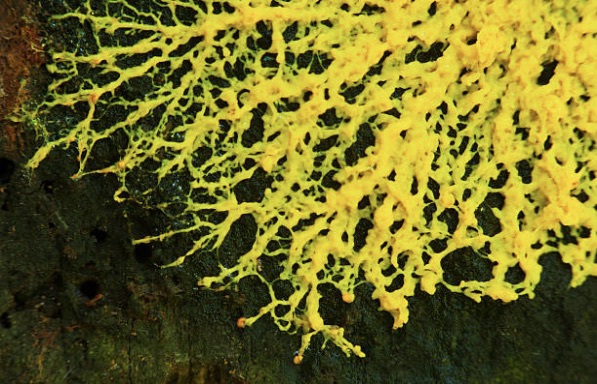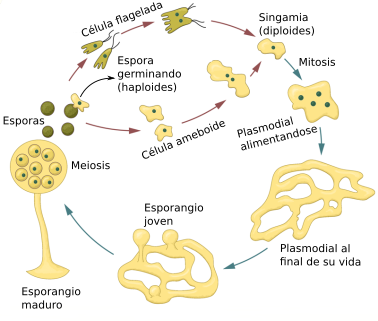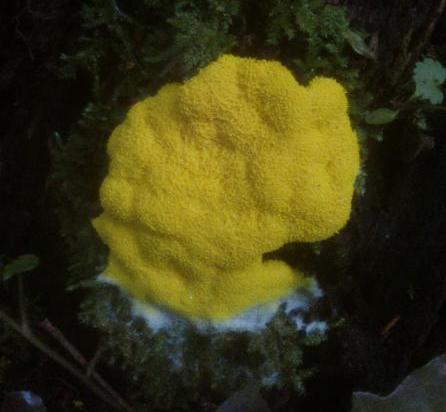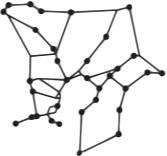
SCIENCE COOKIES
Science articles with chocolate chips
Plasmodial slime mold
Published: 16/10/2020
Author: Javier Pantoja
Nature never ceases to amaze us and this organism is proof of this. Slime mold or plasmodial slime mold are names given to a group of eukaryotic organisms that look like a gelatinous substance and move through their habitat absorbing fungi, decaying organic matter and even other slime molds.
They can be of different colors, depending on the species; most are transparent, yellow or white, but they can also be found reddish, green and blue. They can also reach up to one meter in diameter.

Fungus, bacteria, animal?
For a long time it was believed that they were a species of fungi, this was mainly due to the fact that their life cycle is very similar and similarities were also found with some bacteria, but that does not imply that they are related. In the same way, it was classified as an animal because it has a cell membrane like animal cells. They are currently considered protist amoebae.
There are two main groups of slime molds:
- Cellular slime mold : They spend most of their lives as unicellular organisms, but upon release of a chemical signal, they can coalesce to form a simple multicellular organism. This makes them very useful when studying the evolution of multicellular organisms and cellular communication.
- Plasmodial slime mold : They are unicellular but are much larger and contain millions of nuclei. They are very useful for studying the movement of the cytoplasm and cellular material. This type of slime mold is the main topic of this article.
Lifecycle

Amphibian amoebas
Plasmodial slime molds start life as haploid spores (which process a single set of chromosomes) that are easily spread by wind, rain, and animals. When conditions are favorable, the outer shell of the spore breaks and an amoeboid cell emerges. If the cell is in water, it can develop flagella that they use to swim, and if the environment dries up, they lose them and crawl to get around. If conditions are unfavorable, the amoeba can coat itself in a protective coating and hibernate until conditions are favorable again.
If two amoebas come together and are compatible they can fuse to form a diploid amoeba (which processes two sets of chromosomes). Compatible haploid amoeba pairs can come from spores of the same or different ancestors. As it feeds and grows, its nuclei continue to divide and therefore it is determined plasmodial.
Feeding
Slime mold can travel over surfaces at approximately 1 cm per hour. To do this, it forms a network of vessels in which the cytoplasm and nutrients are transported from one side to the other. They feed by crawling on their food, suffocating and absorbing it. This type of feeding is called phagocytosis. A slime mold's diet is primarily made up of decaying bacteria, fungi, and organic matter and they find their food through their odor.
If you cut a plasmodial slime mold into pieces, each fragment will continue its life as an individual, and if it comes across a piece that shares genetic material, they fuse together again. However, if two different slime molds meet, the larger one will devour the smaller one.
A fluffy death
If certain conditions are met, the slime mold can be primed to sporulate. These conditions are that it runs out of food and that there is light. To do this, the plasmodial looks for a suitable place that is elevated to facilitate the dispersal of the spores. When it finds it, it begins to lose its venous structure and develops stems on which sporangia grow, which contain the spores. The spores are produced through meiosis so they are haploid. When in this stage, it has a foam or sponge-like texture and can even be mistaken for synthetic foam.

Brainless but smart
Slime molds lack any structure that could resemble a brain, since they are a huge cell, they do not have neurons or a nervous system. However, various studies have shown that these organisms are capable of remembering and apparently learning, and they have also managed to solve problems and adapt to environmental stimuli.
There are certain substances that, without being toxic, slime molds avoid, such as caffeine, quinine or salt and there have been experiments that show how they can adapt and ignore the presence of these substances, in a similar way to how humans can ignore certain Repetitive sensations such as a continuous sound or the sensation of clothing on the skin. In addition to that, they can transmit what they learn almost instantaneously to the whole cell, even when between two separate fragments only one learned and then they were put together, the whole group acquired the knowledge.
In a study in Japan, it was shown that slime molds always choose the most efficient way to create their vessels in which they transport nutrients when they feed. In this experiment, oat flakes were placed in positions that resembled the layout of the city of Tokyo and the subway system, when the slime mold began to form its vessels, it did so in such a way that they were the most efficient paths and coincided largely with the real metro network.

Image of Pembroke Oxford College
Slime mold

Tokyo subway

References
https://cronodon.com/BioTech/Plasmodium_SM.html
https://ucmp.berkeley.edu/protista/slimemolds.html
https://www.quantamagazine.org/slime-molds-remember-but-do-they-learn-20180709/





